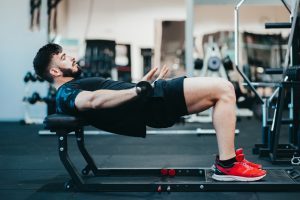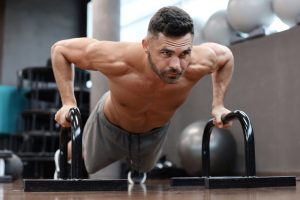Your glutes are the largest and most powerful muscle group in your body, consisting of three muscles that control hip movement, stabilize your entire lower body, and generate explosive power for virtually every athletic movement and daily activity.
Weak glutes lead to lower back pain, knee injuries, poor posture, and compromised athletic performance—but with the right training approach, you can build stronger, more functional glutes in just a few months.
Keep reading to learn exactly how to activate, train, and develop these critical muscles using science-backed strategies that actually work.
Glute Anatomy and Why They Matter Beyond Looks
Your gluteal complex consists of three distinct muscles working together.
The gluteus maximus dominates the show—it's the largest muscle in the entire human body, roughly 1.6 times larger relative to body mass compared to our closest primate relatives.
This powerhouse muscle shapes your buttocks and drives hip extension.
Beneath it lies the gluteus medius, a fan-shaped muscle running along your outer pelvis that stabilizes your body during single-leg activities.
The gluteus minimus, smallest and deepest of the trio, assists the medius in controlling hip rotation and maintaining pelvic stability.
These muscles control several critical movements: hip extension (kicking your leg backward), hip abduction (moving your leg sideways away from your body), and both external and internal rotation of your thigh.
The gluteus maximus connects to your iliotibial band, creating a stabilizing link between your hip and knee joints.
Here's what makes strong glutes non-negotiable for anyone serious about fitness or pain-free movement: they function as your body's central powerhouse, stabilizing your pelvis and maintaining proper alignment throughout your lower body.
When your glutes are weak, other muscles must pick up the slack.
Your lower back, hamstrings, and quadriceps compensate in ways they weren't designed for, creating imbalances that cascade into real problems.
Weak glutes contribute to:
- Lower back pain and chronic tension
- ACL tears and other knee ligament injuries
- Patellar tracking problems
- Hip discomfort and reduced mobility
- Ankle instability
- Poor posture and anterior pelvic tilt
Your glutes act as shock absorbers during high-impact activities, protecting your joints from excessive stress.
They prevent inward rotation of your femur—a movement that causes knee valgus, where your knees collapse inward.
This position significantly increases your injury risk during squats, jumps, and cutting movements.
For athletic performance, glutes drive everything that matters.
They power forward propulsion when you run, generate explosive force for jumping, enable rapid changes of direction, and improve your speed and efficiency across virtually every sport.
Hip extension—the primary job of your gluteus maximus—is arguably the single most important factor in your ability to run faster and move more powerfully.
Sprinters, jumpers, and athletes who dominate their sports all share one common trait: exceptionally strong, well-developed glutes.
The Sitting Epidemic and Gluteal Amnesia
Modern sedentary lifestyles have created what trainers call “sleepy glutes” or gluteal amnesia—and if you spend most of your day sitting, you probably have it.
Here's what happens: when you sit for prolonged periods, your hip flexors remain shortened and tight while your glutes stay inactive and disengaged.
Over time, your nervous system essentially forgets how to properly activate these muscles.
This creates a phenomenon called reciprocal inhibition.
Your tight hip flexors don't just sit there passively—they actively prevent your glutes from firing correctly.
It's a neurological conflict where one muscle group's tension suppresses another's activation.
Think of it like trying to press the gas pedal while someone else holds down the brake.
The consequences spiral outward from there. Your pelvis tilts forward (anterior pelvic tilt), placing excessive stress on your lumbar spine.
This misalignment forces other muscles to compensate, creating a dysfunction and pain cycle that worsens the longer it continues.
You might notice lower back tightness, hip discomfort, or difficulty feeling your glutes work during exercises.
Office workers and anyone with a sedentary job face this issue most acutely.
Eight hours at a desk, followed by a commute, followed by sitting at home—you're looking at 10+ hours of glute deactivation daily.
Your body adapts to what you do most often, and if sitting dominates your day, your glutes essentially go offline.
The good news? Gluteal amnesia is completely reversible through consistent activation and strengthening protocols.
You're not permanently damaged—your nervous system just needs retraining to remember how to engage these muscles properly during movement.
Most Effective Exercises and Activation Strategies
EMG (electromyography) research has settled the debate on which exercises produce the highest glute activation.
The data gives us clear winners, though each serves a specific purpose in your training.
Hip thrusts reign supreme for gluteus maximus development.
They challenge your glutes in a shortened position at full hip extension, creating maximum tension when the muscle is fully contracted.
Studies comparing hip thrusts to squats found they produce similar hypertrophy but with more specificity—you get glute growth with less quad and adductor recruitment.
If you want to prioritize glute development, hip thrusts deliver the most bang for your buck.
Step-up variations produce over 100% of maximal voluntary isometric contraction in some studies, making them exceptionally effective.
The unilateral nature forces each glute to work independently, which corrects left-right imbalances you might not even know you have.
Squats remain essential despite not producing the highest peak activation.
When you perform them with proper depth—hitting parallel or slightly below—they create significant mechanical tension and muscle damage, both needed for growth.
The key is maintaining a slight forward torso lean and driving through your heels rather than your toes.
Done right, squats build your entire lower body while heavily taxing your glutes.
Deadlifts and their variations (Romanian, sumo, stiff-leg) provide massive loading potential and work your entire posterior chain.
Romanian deadlifts particularly emphasize the stretch position, creating significant muscle damage and metabolic stress that triggers growth.
Single-leg exercises like Bulgarian split squats, single-leg Romanian deadlifts, and walking lunges address imbalances while increasing the challenge to your stabilizing muscles, including your gluteus medius and minimus.
These smaller glute muscles often get neglected in bilateral movements but play a critical role in pelvic stability and injury prevention.
Pre-training activation: waking up your nervous system
Before diving into heavy training, you need glute activation exercises.
These movements prepare your neuromuscular system to recruit the right muscles, creating a mind-muscle connection that ensures your glutes—not your hamstrings or lower back—do the primary work during your workout.
Effective activation drills include:
- Glute bridges
- Clamshells with resistance bands
- Fire hydrants
- Donkey kicks
- Lateral band walks
- Single-leg glute bridges
Spend 5-10 minutes on activation using bodyweight or light resistance bands.
Focus on slow, controlled movements with a 1-2 second pause at peak contraction.
The goal isn't fatigue—it's neural activation and creating awareness of proper glute engagement.
Research demonstrates that activation warm-ups potentiate your glutes so that a smaller neural drive produces the same or greater force during movement.
Translation: your glutes fire more efficiently when you prime them first, leading to better exercise execution and results.
Training Frequency, Volume, and Progressive Overload

How often should you train glutes? The research-backed answer is 2-6 times per week, depending on your training experience and recovery capacity.
Training volume by experience level:
- Beginners: 2-3 sessions weekly, 10-15 total sets for glutes
- Intermediate: 3-4 sessions weekly, 15-25 sets
- Advanced: 4-6 sessions weekly, 20-35+ sets distributed across multiple sessions
Understanding exercise classification changes everything about how you structure your training.
Exercises fall into three categories based on recovery demands: stretchers, activators, and pumpers.
Stretchers create significant muscle damage—think squats, lunges, and Romanian deadlifts.
These require 2-3 days recovery before hitting the same movement pattern again.
Activators produce moderate damage (hip thrusts fall here), while pumpers create minimal damage (band exercises, lighter glute bridges).
You can train with pumpers daily, but stretchers need adequate rest between sessions.
Each training session should include 3-6 different exercises covering various movement patterns.
Hit hip extension movements like hip thrusts and bridges, hip hinge movements such as deadlift variations, squatting patterns, abduction movements for your gluteus medius and minimus, and single-leg exercises to address imbalances.
Progressive overload: the non-negotiable principle
Without progressive overload—gradually increasing demands on your muscles—you won't see continued improvement.
Your body adapts quickly to the same stimulus, so you need to keep challenging it in new ways.
You can achieve progressive overload through multiple methods:
- Increase the load in small increments (typically 2.5-5 pounds)
- Increase volume with additional sets or repetitions
- Improve exercise technique to create better tension on target muscles
- Increase training frequency with additional weekly sessions
- Manipulate tempo—slow down the eccentric phase or add pauses at peak contraction
- Decrease rest periods to increase metabolic stress
- Change exercise variations to provide novel stimuli
The most straightforward approach involves increasing resistance over time while maintaining excellent form.
If you can complete your target rep range with good form, increase the weight slightly the following week.
Track your workouts meticulously—without data, you have no idea whether progression is actually occurring.
Write down exercises, weights, sets, and reps every single session.
Common Training Mistakes That Sabotage Your Progress
Many online workouts emphasize hip abduction movements—think banded clamshells and side-lying leg raises—over hip extension exercises.
While abduction work has its place for developing your gluteus medius, hip extension is the primary function of your glutes and should dominate your programming.
Prioritize compound movements like squats, deadlifts, and hip thrusts.
These exercises load your glutes with substantial weight and create the mechanical tension needed for growth.
Form errors that shift work away from your glutes:
Poor technique doesn't just reduce results—it actively trains the wrong muscles.
At the top of hip thrusts and glute bridges, many people overextend by arching their lower back instead of tucking their pelvis.
This shifts tension from your glutes to your lumbar spine, defeating the entire purpose of the exercise.
Focus on posterior pelvic tilt at the top—squeeze your glutes hard and tuck your pelvis under.
Quadriceps-dominant squat patterns plague gym floors everywhere.
Your knees travel too far forward without sufficient hip hinge, turning squats into a quad exercise.
Push your hips back as you descend, maintain a slight forward torso lean, and drive through your heels rather than your toes.
Insufficient depth on squats and lunges also robs you of glute activation—you need to hit parallel or slightly below to fully engage the muscle.
Lifting the same weights week after week provides no new stimulus for growth. Your muscles adapt quickly and require increasing challenges.
This connects directly to the progressive overload principle covered earlier—without it, you're just spinning your wheels.
Track your numbers and push for improvement.
Training exclusively in the forward and backward plane (sagittal plane) neglects your gluteus medius and minimus.
These muscles control lateral movement and hip stability.
Include side lunges, lateral band walks, and curtsy lunges to develop all three glute muscles comprehensively.
Here's a specific mistake that confuses many people: placing resistance bands around your knees during vertical exercises like squats and hip thrusts.
This creates lateral resistance that conflicts with the vertical resistance of the exercise, forcing your body to fight two opposing forces simultaneously.
Save bands for dedicated abduction work where lateral resistance makes sense.
Finally, insufficient nutrition undermines everything.
Building muscle requires adequate calories and protein—no amount of training will grow your glutes if you're not fueling your body appropriately.
Aim for a small caloric surplus with 0.7-1 gram of protein per pound of bodyweight.
You can't build tissue without the raw materials to construct it.
Maximizing Results: Mind-Muscle Connection and What to Expect
The mind-muscle connection—consciously focusing on contracting specific muscles during exercise—can significantly enhance your results.
Research demonstrates that individuals who actively focus on muscle contraction experience better muscle fiber recruitment and hypertrophy compared to those who perform exercises passively.
This isn't just gym bro science; it's a documented neurological phenomenon.
Start developing this connection with daily isometric practice.
Lie down and contract your glutes for 10 seconds without any movement.
Use your hands to palpate the muscle and ensure it's actually contracting.
Alternate between your left and right glute for two minutes daily.
This simple drill rewires your nervous system to activate these muscles on command.
During exercises, use specific internal cues: “squeeze your glutes as if holding a dollar bill between your cheeks,” “drive your hips toward the ceiling,” “push through your heels,” and “extend your hips fully at the top.”
Visualization helps tremendously—before each set, visualize your glutes contracting and extending through the movement.
The mind-muscle connection works best at 20-60% of your one-rep max for isolation exercises.
Start with lighter weights where you can maintain focus.
As weight increases beyond 60% of your maximum, your focus naturally shifts to just completing the movement, which is fine for heavy compound lifts.
Slow, controlled repetitions with pauses enhance this connection. Try a 3-0-1 tempo (three seconds down, no pause, one second up) or add 2-second pauses at the top of hip thrusts.
Sample weekly structure for intermediate trainees:
Day 1 focuses on heavy glute work: barbell hip thrusts, Bulgarian split squats, Romanian deadlifts, and banded lateral walks.
Day 2 shifts to lower body emphasis: back squats, walking lunges, wide stance leg press, and cable pull-throughs.
Day 3 delivers a lighter pump session: single-leg hip thrusts, curtsy lunges, single-leg Romanian deadlifts, and frog pumps.
Rest 48-72 hours between high-intensity glute sessions.
Use lighter “pump” workouts on shorter rest periods to increase training frequency without compromising recovery.
This approach lets you train glutes more frequently while respecting the recovery demands of different exercise types.
Timeline for results:
With consistent training, proper nutrition, and progressive overload, expect subtle improvements in glute activation and muscle firmness within 4-6 weeks.
Noticeable visible changes in size and shape typically emerge around 8-12 weeks.
Significant, unmistakable transformation occurs after 6-12 months of intelligent, consistent training.
Genetics, training history, nutrition quality, sleep, and stress management all influence this timeline—some people respond faster, others need more patience.
Special considerations:
If you struggle to feel your glutes working during exercises, regress to bodyweight movements and master the activation drills.
Practice glute bridges daily, focusing exclusively on technique until you can confidently contract your glutes on command.
Consider working with a qualified trainer who can provide tactile cueing and form corrections—sometimes you need external feedback to understand what proper glute engagement feels like.
For those dealing with knee or back pain, start conservatively with glute bridges and work on hip mobility before progressing to loaded squats and deadlifts.
Many common pain patterns actually stem from weak glutes, so strengthening them often alleviates symptoms over time.
Avoid excessive cardio during glute-building phases.
Hours of steady-state cardio can interfere with recovery and muscle growth.
If you enjoy cardio, limit it to 2-3 moderate sessions weekly or incorporate sprint intervals, which actually enhance glute development rather than hindering it.
Your body has limited recovery resources—spend them wisely on the training that aligns with your goals.
Conclusion
Your glutes are far more than aesthetic muscles—they're the foundation of athletic performance, daily movement, and injury prevention.
Focus on progressive overload with compound movements, ensure proper activation before training, and master the mind-muscle connection while staying patient with the process.
Your efforts will compound over time, delivering both the functional strength and visible results you're pursuing.







